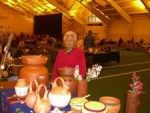Native American Culture Celebrated at Colgate

On Saturday, November 4, Sanford Field House was transformed from its usual athletic facilities into a lively celebration of Native American culture. Organized by Longyear Museum curator Carol Ann Lorenz, the Native American Studies Department and the Native American Student Association, the Native American Arts & Culture Festival brought a world of traditional dance, music and artwork to the Colgate campus, educating the community and providing a venue for cultural expression.
The day began with a performance by Cayuga flutist Dan Hill. Hill, who also sold flutes and silver pieces at the festival, soothed his audience with ethereal melodies. Five different flutes were played, each with its own tone and cultural significance.
“What I hear coming from the notes of the flutes are the stories that my grandmother would tell me,” Hill said. Hill prefaced each song with stories of environmental injustice. “We must remember that everything is related,” he warned. “What we do to the land is coming back.”
Picking up the pace, the Haudenosaunee Singers and Dancers, lead by Sherri Waterman Hopper, took the stage. The group, featuring performers of all ages, hails predominantly from the Onondaga nation but on Saturday also included Tuscarora and Cherokee dancers. Among the dancers was Colgate alumna Leyosta Hall ’06.
Dressed in ceremonial clothing, the troupe showcased social dances of the Haudenosaunee, which includes the Oneida, Seneca, Tuscarora, Onondaga, Mohawk and Cayuga nations. These dances are not ceremonial – they are used to lift spirits and to welcome newcomers into the community. The group performed eight dances, all set to the voices and percussion of the troupe’s musicians. Festival visitors were welcome to take part in the dancing, and many found themselves participating and having a great time.
Next, Kay Olan of the Mohawk tribe told traditional stories and legends of the Iroquois. The tales ranged from explanatory stories, which told, for example, why vulture’s heads are red or why the leaves change color in autumn, to the creation story that details how the Iroquois believe the world came to be. Lively, personable and thorough, Olan’s technique entertained the audience while simultaneously educating about the beliefs and stories of her people.
“We need to share these stories because that’s when we find out that we are all connected,” Olan said. “We find out that we don’t need to fear each other. We can disagree, but we can understand without going to war, without fear, without anger. We all have the same mother, Mother Earth.”
The festival again turned to music as Diane and Leah Shenandoah, back-up singers for renowned musician Joanne Shenandoah, performed contemporary Iroquois songs. Sung both in English and in their native language, the Oneida women enchanted listeners with their simple yet beautiful harmonies. Accompanied solely by Schenandoah’s drumbeats, the songs combined traditional and contemporary themes.
In the midst of all of the performances, over 40 artisans and vendors showcased their work. Dozens of booths were covered in beadwork, clothing, pottery, baskets, musical instruments and many other forms of art, all symbolizing years of training and hard work. Traditional American Indian food was also available for visitors, including corn soup, fry bread and tacos.
Additionally, many of the artists gave demonstrations of their work. Alfred Jacques of the Onondaga nation drew large crowds as he made authentic lacrosse sticks. Mohawk/Cree member Alan Cleveland displayed his highly refined talent while demonstrating the making of indigenous flutes. Tom Huff, a Seneca and Cayuga artist, gave a workshop on stone carving.
Combining art, education and fun, Saturday’s Native Americans festival was an event to remember. In case you missed it, mark your calendars – next year’s festival is scheduled for November 3, 2007.






